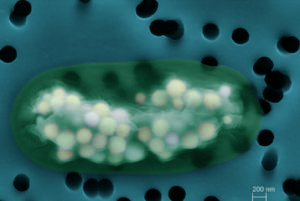A new species of photosynthetic bacterium has come to light: it is able to control the formation of minerals (calcium, magnesium, barium and strontium carbonates) within its own organism. Published in Science on April 27, 2012, a study by French researchers[1] reveals the existence of this new type of biomineralization, whose mechanism is still unknown. This finding has important implications for the interpretation of the ancient fossil record.
Cyanobacteria have long attracted scientists’ attention. Capable of photosynthesis,[2] these microorganisms have played a major role in Earth’s history, in particular by contributing to the oxygenation of the atmosphere. Some cyanobacteria are able to form calcium carbonate[3] outside their cell, especially those associated with stromatolites, carbonate rocks that date back some 3.5 billion years and are among the earliest traces of life on Earth. Fossil cyanobacteria should therefore be present within this type of formation. However, the first fossil cyanobacteria go back a mere 700 million years, well after oxygen levels in Earth’s atmosphere started to rise some 2.3 billion years ago.
A French team[1] may have found the reason for this long time lapse. In stromatolites collected in a crater lake in Mexico and cultured in the laboratory, the scientists discovered a new species of cyanobacterium, called Candidatus Gloeomargarita lithophora. This microorganism descends from a lineage that diverged early on in cyanobacteria. Thanks to an as yet unknown biomineralization mechanism, this cyanobacterium forms intracellular calcium carbonate nanoparticles of around 270 nanometers (270 billionths of a meter). While some cyanobacteria were known to form extracellular calcium carbonate within stromatolites, their formation within the cell had never been observed. Another distinctive feature of the new species is that it accumulates strontium and barium and incorporates them into the carbonate.
This finding is significant for the interpretation of the ancient fossil record. If the cyanobacteria associated with stromatolites formed carbonates inside their cells rather than outside, they would not have been preserved in the fossil record. This would explain the time lapse between their earliest appearance (at least 2.3 billion years ago) and the oldest fossils discovered (700 million years ago). The next step is to find out why and how this cyanobacterium produces the calcium carbonate.
1 –The team is made up of researchers from the Institut de minéralogie et de physique des milieux condensés (CNRS/UPMC/Université Paris Diderot/IPGP/IRD), the Laboratoire écologie, systématique et évolution (CNRS/Université Paris-Sud), the Laboratoire de minéralogie et de cosmochimie du Muséum (Muséum national d’Histoire naturelle/CNRS), the Institut de Physique du Globe de Paris (CNRS/IPGP/Université Paris Diderot), in collaboration with Stanford University (United States).
2 — Photosynthesis allows cyanobacteria to capture light energy thanks to pigments that produce organic matter from carbon dioxide while releasing oxygen as a waste product.
3 — Calcium carbonate, of which chalk, limestone and marble are made, also makes up corals, shells of snails and other animals, and stromatolites.



 May 12th, 2012
May 12th, 2012  riffin
riffin 
 Posted in
Posted in 